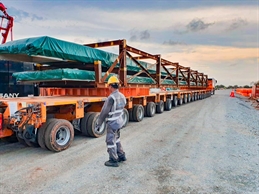
deugro said it was contracted by GE to execute this complex project within a period of 12 months which requires components of the project to be moved from various origins in Asia, Europe and the USA to the construction site in Jakarta, Java.
In a statement, it said the cargo included two 438-metric-ton gas turbine 9HA .02 units, two 460-metric-ton generator stator (GEN STAT) units and 52 heat recovery steam generators (HRSGs) with a length of 30 meters and weights of up to 240 metric tons.
deugro said it executed the project in cooperation with dteq, a company of the deugro group focused on complex transport engineering services.
The project’s challenges included limitations at the site jetty in West Cilamaya, Java, which allowed only one barge to berth at a time, and the road from the port to the construction site, which led through several space-limited villages.
It also cited space limitations for the HRSG module storage at the Port of Tanjung Priok, Jakarta, and a limited feasibility to transfer the gas turbine and gas turbine generators had to be considered.
“Our solution was to have a strong transport concept that was developed together with dteq as well as local experts, considering possible limitations from the start and helping us during the execution stage to allow for safe transport at all times,” said Daniel Wolfenstetter, assistant country manager, PT deugro Indonesia.
deugro Jakarta calculated the maximum transport dimensions and weight for the road freight and identified the units that could not be delivered by road but had to be transported by barge.
“The oversized and heavy lift cargo (OSHL) was discharged directly from the vessel onto the barges at the Port of Tanjung Priok. This led to massive cost and time savings, as well as risk mitigation, since double-handling, storage in the port and re-loading onto barges were avoided,” said Hagen Hennig, regional head of Transport Engineering APAC, dteq, Germany.



